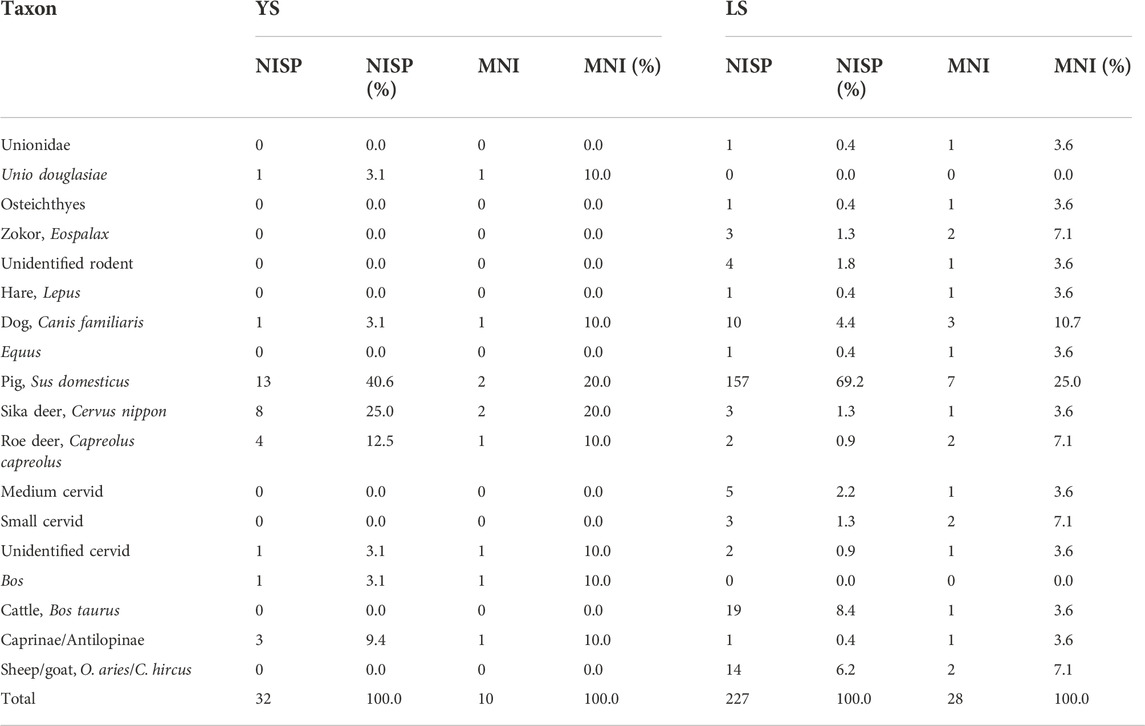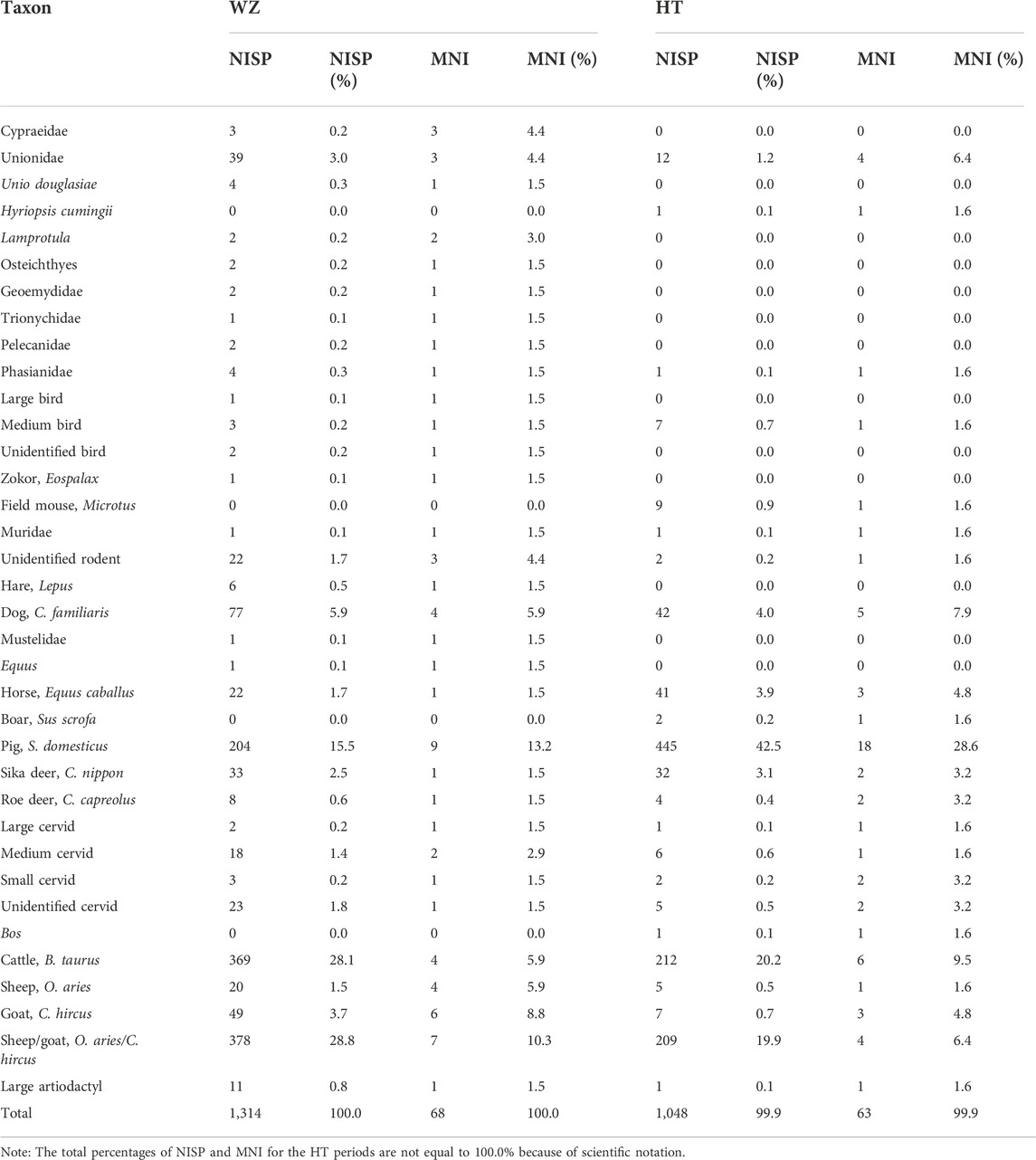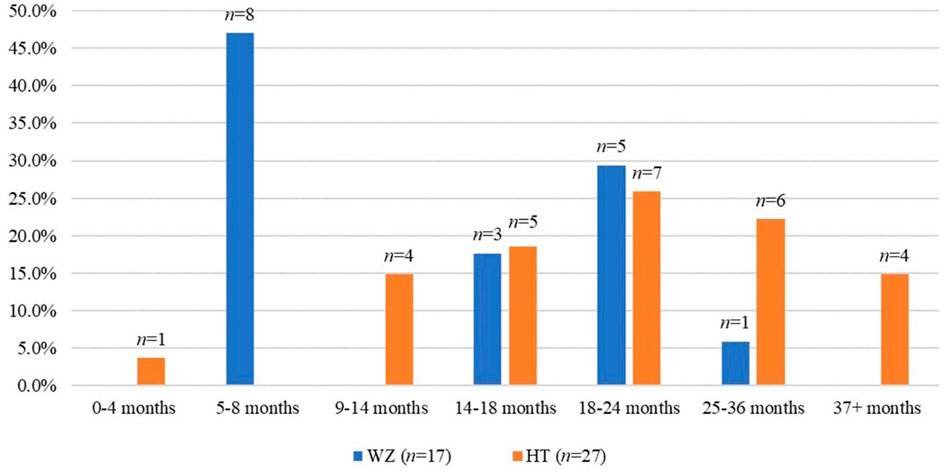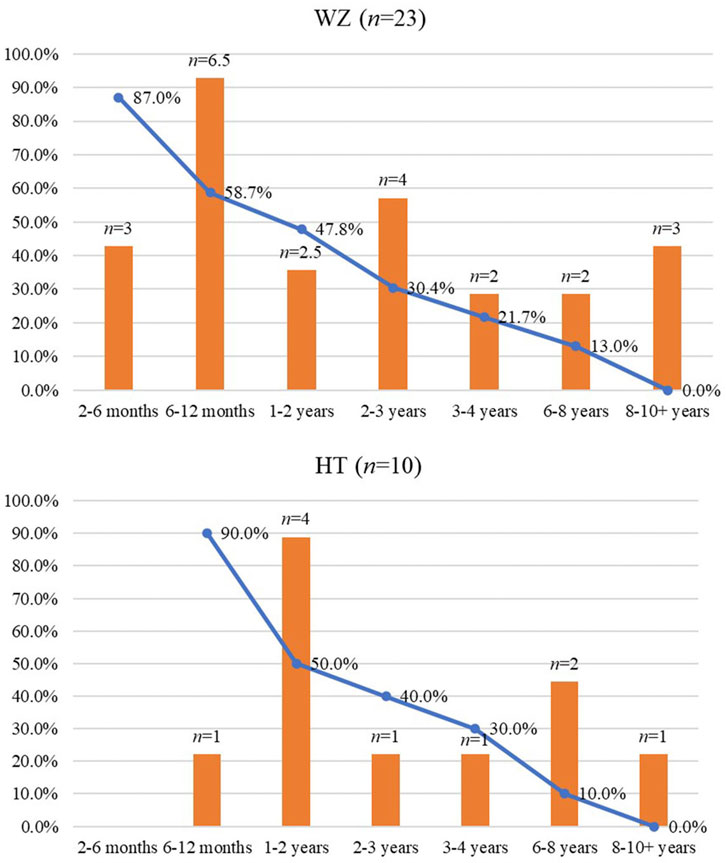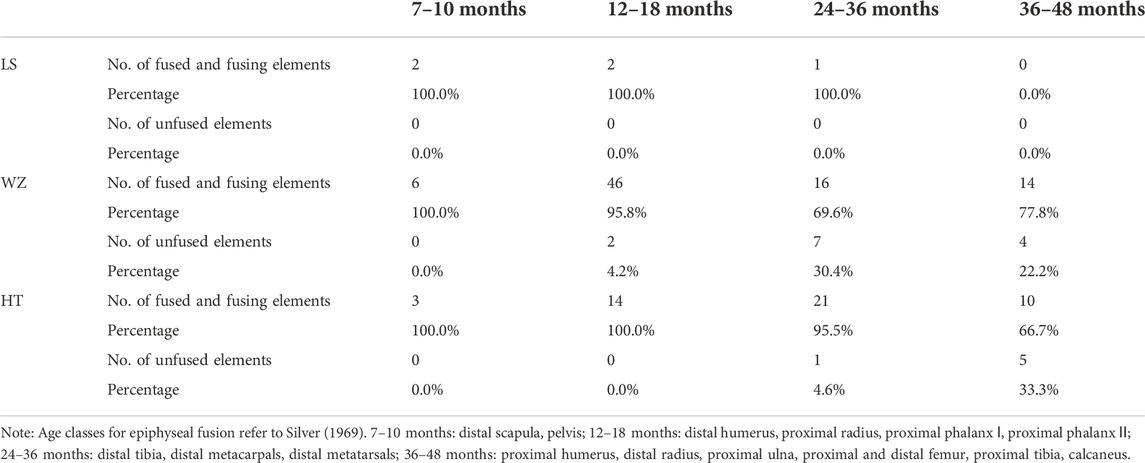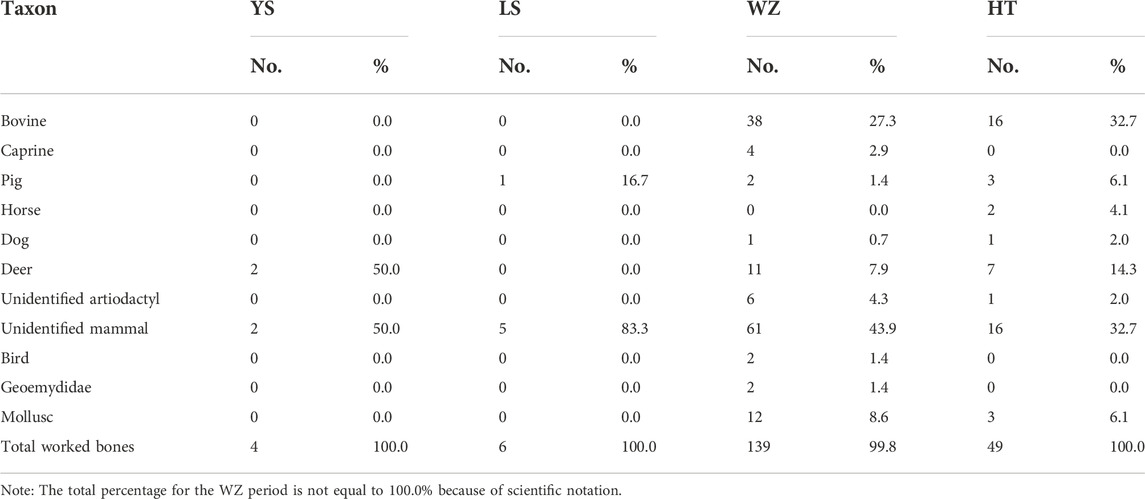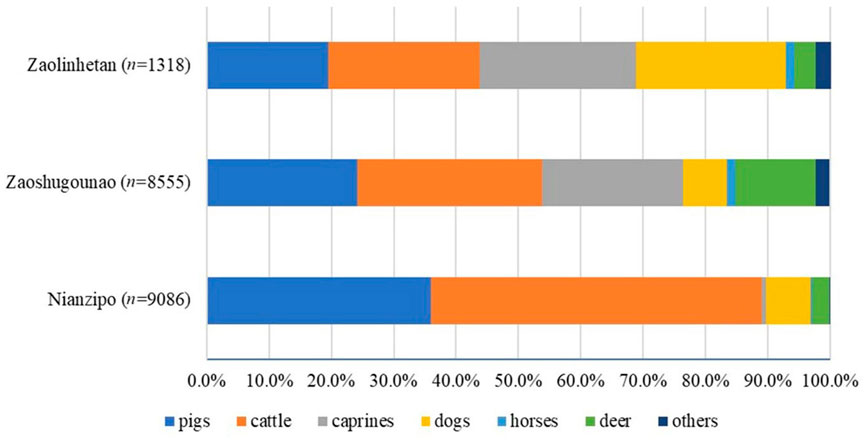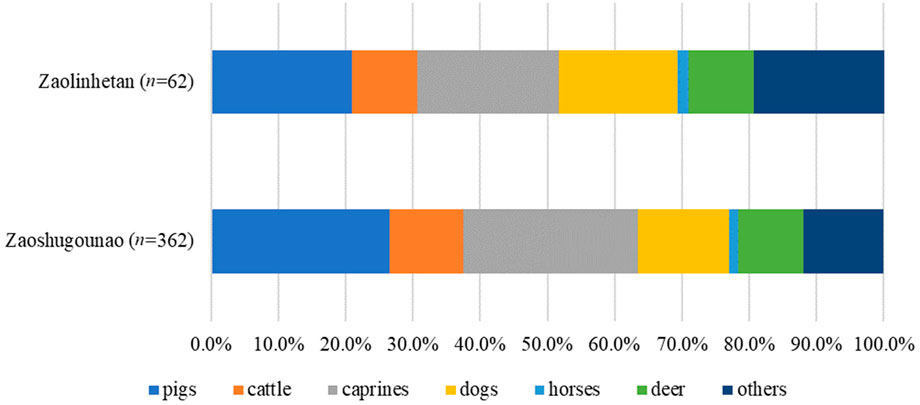- 1School of Cultural Heritage, Northwest University, Xi’an, China
- 2The Ministry of Education Key Laboratory of Cultural Heritage Research and Conservation Technology, Northwest University, Xi’an, China
- 3China-Central Asia Belt and Road Joint Laboratory on Human and Environment Research, Northwest University, Xi’an, China
Zooarchaeological approach has been effective in providing insights into human subsistence practices, which laid essential economic foundation for social, cultural, and political developments in the past. The Guanzhong region in northern China played a crucial role in the origins and evolution of ancient Chinese civilization. Previous research on subsistence economies of ancient societies in the Guanzhong region, human exploitation of animal resources in particular, has largely focused on the late Neolithic period or the Bronze Age. Insufficient work has been done for historical periods post-dating the end of the first millennium BCE. There is also a dearth of research on the long-term chronological changes. Here, we present a preliminary analysis of animal remains from the Nantou Locale of the Xitou site, a large settlement located in the northern Guanzhong region. Results show that pigs played a dominant role in the site’s animal economy during the Neolithic Yangshao and Longshan periods (ca. 5000–2000 BCE). The growing importance of cattle and caprines was documented for the Bronze Age Western Zhou period (ca. 11th-8th centuries BCE). In the Han-Tang periods (ca. second century BCE-tenth century CE), pigs regained their significance in local subsistence practices. Differences in the strategies for animal resource exploitation were possibly associated with changing social and environmental factors. Alongside other relevant archaeological evidence, our zooarchaeological data demonstrate the contribution of diversified animal use strategies to sustained development of subsistence economy in the northern Guanzhong region across millennia. The examination of long-term human-animal interactions in the Guanzhong region allows for a better understanding of changing economic, social, and political landscapes in ancient China.
Introduction
Subsistence economy serves as a fundamental material basis for the maintenance and evolution of human societies. The exploitation of animal resources, in particular, played crucial roles in shaping economic, social, and political landscapes in the past. Examining animal remains from archaeological contexts can thus facilitate our understanding of ancient human-animal interactions involving food consumption, ritual practices, trades, and land use strategies, to name but a few (Crabtree, 1990; Zeder, 1991; Davis, 1995; O’Connor, 2000; Reitz and Wing, 2008; de France, 2009; Albarella et al., 2017; Gifford-Gonzalez, 2018; Rowley-Conwy, 2018).
The Guanzhong region, also commonly referred to as the Jing and Wei River valleys in present-day central Shaanxi Province of China (Shi, 1963), is one of the key regions for understanding the origins and development of ancient Chinese civilization. The region experienced population growth and cultural prosperity in prehistoric Yangshao period, and later became the political hinterland of Zhou, Qin, Han, and Tang, several most influential dynasties that contributed to the formation and consolidation of some major cultural traditions and political institutions in Chinese history (Liu, 2004; Liu and Chen, 2012; Underhill, 2013; Shelach-Lavi and Jaffe, 2014; Shelach-Lavi, 2015). Transformations in various aspects in ancient Guanzhong region profited, in large part, from the development and intensification of animal husbandry and crop cultivation, alongside other technological innovations. Investigating subsistence practices is thus beneficial to a more holistic understanding of the economic, social, and political milieu of ancient Guanzhong region.
Previous research on animal remains from archaeological contexts has illustrated the multiple roles of animals in early human subsistence actions in the Guanzhong region (see Hu and Yuan, 2021 for a review). Nevertheless, most of these studies centered on the Wei River valley, with a focus on the late Neolithic period or the Bronze Age. Zooarchaeological data from the Jing River valley remain scarce, particularly those of historical periods post-dating the end of the first millennium BCE. There is also a lack of work on the long-term changes in animal resource exploitation in the prehistory and history of the region.
The northern Guanzhong region generally incorporates the middle and lower reaches of the Jing River. The middle Jing River valley has been considered as where the ancient Bin area was located, an area pertaining to the rise of the Zhou people in historical texts (Niu, 2000; Zhang, 2001; Gong, 2018). Animal remains from excavated sites in this region, such as Nianzipo, Xiaweiluo, Zaolinhetan, and Zaoshugounao were mostly from contexts of a relatively restricted range of time span (Cultural Heritage Archaeology Research Center of Northwest University, andShaanxi Academy of Archaeology, 2006; Institute of Archaeology CASS, 2007; Wang and Chen, 2010; Li et al., 2012; Liang, 1999; Wang et al., 2013; Zhai et al., 2018; Dou et al., 2019; Zhao et al., 2022). Recent archaeological fieldwork at the Nantou Locale of Xitou, a large settlement in the middle Jing River valley, has uncovered animal skeletal elements from contexts dated to a wide range of periods, which facilitate the exploration of chronological changes in past animal use in the region.
Here, we report an analysis of animal remains from the Nantou Locale. Integrating zooarchaeological data with evidence from published archaeobotanical and environmental research, we investigated potential changes in subsistence practices in relation to animal use across millennia in the northern Guanzhong region and the underlying dynamics that might explain these changes.
The site of Xitou
Xitou (35°02′15.56″N, 108°12′59.68″E) is located in modern Xunyi County of western-central Shaanxi Province, 1,125 m above sea level (Wei et al., 2020) (Figure 1). The site sits on a loess platform and sloping edge, approximately 5 km southwest of the Jing River (Dou et al., 2021) (Figure 2). Past field surveys show that the site covers an area of approximately 100 ha, with human occupation spanning from the late Neolithic to historical periods (Dou et al., 2021).
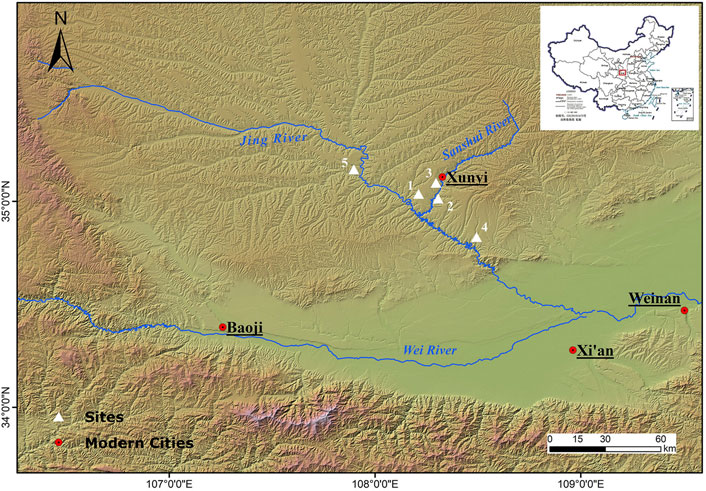
FIGURE 1. The location of archaeological sites in the middle Jing River valley, mentioned in this research. 1) Xitou; 2) Zaolinhetan; 3) Xiaweiluo; 4) Zaoshugounao; 5) Nianzipo.
To better understand early settlement patterns and subsistence economies in the middle Jing River valley, the School of Cultural Heritage at Northwest University and partner institutions carried out excavations at the Nantou Locale in 2018, the southern section of the site. The archaeological fieldwork revealed an area of 625 m2 and recovered cultural remains from more than 200 pits, ditches, hearths, kilns, and burials, dated to the Yangshao (ca. 5000–3000 BCE), Longshan (ca. 3000–2000 BCE), Western Zhou (ca. 1050–771 BCE), Han-Tang (ca. second century BCE-tenth century CE), and Ming-Qing periods (ca. 14th-20th centuries CE).
Materials and methods
In this study, we analyzed a total of 4,786 animal skeletal elements recovered from 103 pits and three ditches at the Nantou Locale (hereafter referred to as Xitou, the name of the site), dated to the Yangshao (YS), Longshan (LS), Western Zhou (WZ), and Han-Tang (HT) periods. The largest proportion of animal remains were unearthed from contexts of the WZ period. All animal specimens were collected by hand. Screening was not applied during excavation, which may have underrepresented bones of small mammals and non-mammals.
We identified animal species using published guides (von den Driesch, 1976; Hillson, 1992; Schmid, 1972) and archaeological and modern reference collections in the School of Cultural Heritage, Northwest University. Skeletal elements that can be identified to at least the family level were included in the calculation of NISP (the number of identified specimens) and MNI (the minimum number of individuals). In the following sections, small size deer that cannot be identified to species, such as musk deer and muntjac, were collectively referred to as “small cervids”. Similarly, specimens identified as sheep (Ovis aries), goat (Capra hircus), and sheep/goat (O. aries/C. hircus) were grouped as “caprines” where necessary. In addition, we calculated the proportion of NISP or MNI of a given animal species from other relevant sites and used the average value to represent the proportion of this species. The proportion of absolute quantity of charred plant seeds was calculated in the same way during the discussion.
Dental eruption and wear of mandibles on both sides were used to construct mortality profiles of pigs and caprines (Silver, 1969; Payne, 1973; Grant, 1982; Ma, 2007; Li, 2011b). When an age estimate of one specimen covered two age groups, this specimen was counted 0.5 in each age group. Bone epiphyseal fusion (Silver, 1969) was also used to construct mortality profiles of pigs. The mortality profile of cattle younger than 5 years of age was constructed using bone epiphyseal fusion (Silver, 1969), while tooth eruption and wear (Silver, 1969; Grant, 1982) was applied for older ones.
We conducted a chi-square test to compare the NISP of wild and domestic animals from contexts of the YS, LS, WZ, and HT periods. Statistical test was performed in IBM SPSS Statistics software.
Taphonomy
A considerable small number of animal remains analyzed suffered from weathering (1.7%) of varying degrees. Approximately 1.8% and 4.6% of the specimens exhibited rodent gnawing and carnivore chewing, respectively. Traces of burning were recorded in 3.2% of all animal remains. Taphonomic effects, in general, had little impact on the animal assemblages.
Animal species representation
In total, 2,621 specimens from Xitou (54.8% of all animal remains analyzed) were identified to at least the family level, representing a minimum number of 169 individuals (Table 1, Table 2). By NISP, wild species constituted the largest proportion of animal remains from the YS contexts, while domestic animals played dominant roles during the LS, WZ, and HT periods. More specifically, pigs were the most important domestic animals at Xitou in prehistory (YS and LS). Caprines and cattle were incorporated into the site’s subsistence practices during the LS period, although their proportion was apparently small. This structure of domestic animals changed in the Bronze Age (WZ), during which caprines and cattle outnumbered pigs. Animal species representation at Xitou in historical period (HT) was similar to that of the YS and LS periods, with pigs returning to dominate the animal assemblage.
Wild animals took up 56.3%, 11.9%, 14.8%, and 8.3% of the total NISP for the YS, LS, WZ, and HT periods, respectively. It is worth mentioning that an equine skeletal element was found in animal assemblage of the LS period. Recent ancient DNA analysis suggests that certain wild equine species, such as Equus ovodovi, were still present in northern China during the Neolithic period (Zhu, 2020; Hu et al., 2022). Given that genetic data for the equine specimen from Xitou is currently unavailable, we identified this specimen to Equus. Chi-square test suggests that the four periods (YS, LS, WZ, and HT) are statistically different in terms of the NISP of wild and domestic animals (χ2 = 79.674, df = 3, p < 0.00).
Mortality profiles and animal use at Xitou
Pigs
A total of 49 pig mandibles (YS: n = 2; LS: n = 3; WZ: n = 17; HT: n = 27) were available for age estimation using dental wear. Specifically, the two individuals from the YS contexts died at 14–18 and 25–36 months old, while the three individuals of the LS period were culled at 5–8, 9–14, and 37+ months old, respectively. The mortality profiles for pigs of the other two periods (WZ and HT) indicate that the largest kill-off all occurred at the age stage of 1–2 years (Figure 3). In terms of dental eruption of HT periods, two specimens were 6–12 months old, two specimens were 12–16 months old, two specimens were younger than 1–1.5 years of age, and 18 specimens were older than 7–22 months old. With respect to bone epiphyseal fusion (LS: n = 41; WZ: n = 64; HT: n = 88), most pigs of the LS and WZ periods died before 2 years of age, with 55.5% of individuals from the WZ contexts being culled before 1 year old (Supplementary Table S1). Bone epiphyseal fusion data for the HT periods were basically consistent with the data on dental wear.
Normally, the major purpose of pig husbandry is for acquiring pork. In order to receive a higher rate of return, 80.0% or higher proportion of juvenile individuals would often be maintained to acquire more meat yields (Ma, 2007). In terms of dental wear and bone epiphyseal fusion, pigs were mainly culled at an optimum slaughter age of 1–2 years old (Li, 2011b) during the WZ and HT periods at Xitou. This suggests that pigs were raised for pork across time. Furthermore, the apparently large proportion of pigs aged 5–8 months old (47.1%) in the WZ assemblage might reflect a preference for tender meat. Existing studies have shown that the consumption of tender pork likely existed in both prehistoric and Bronze Age sites in northern China, such as Zaoshugounao, Zaolinhetan, and Yinxu (Li, 2011a; Li et al., 2020). In addition, pig mortality profile of the WZ period shows an absence of neonatal individuals, and only one individual died at 2–3 years old. Based on field survey results, the scale of Xitou was large during the Bronze Age (Dou et al., 2021). Pork may have been provisioned to Xitou from adjacent areas during the WZ period. That being said, due to the small sample size, future fieldwork and research may help to gain a better understanding of pig consumption and provision at Xitou during the Bronze Age.
Caprines
We documented dental eruption and wear of 42 caprine mandibles (WZ: n = 28; HT: n = 14). Dental wear data suggest that most caprines from the WZ contexts were culled at the age of 6–12 months, with nearly one quarter (21.7%) of individuals surviving to 6 years old (Figure 4). In terms of the HT periods, 30.0% of caprines survived beyond the age of 6 years and most caprines died at 1–2 years of age. According to dental eruption, two specimens were younger than 21–24 months (WZ: n = 1; HT: n = 1), and seven were older than 18–24 months (WZ: n = 4; HT: n = 3). Bone epiphyseal fusion data for the three specimens from the LS contexts suggest that these caprines died before 3 years of age.
Caprines would be culled in large quantity at the optimum slaughter age if the major purpose of herding is for meat consumption, while a pursuit for milk and wool would result in a focused kill-off on individuals younger than 2 months old and a higher mortality rate of elder individuals, respectively (Payne, 1973). Meat yield of caprines normally reached the peak at 1.5–2.5 years of age (Li, 2011a), and a focused culling on individuals of 6–12 months old has been associated with tender meat acquisition (Vigne and Helmer, 2007). In the case of Xitou, the equal death number of caprines aged 6–12 months and 1–3 years of the WZ period might reflect a preference for meat, particularly tender meat. In fact, similar kill-off patterns have been recorded for other Bronze Age sites in the Central Plains, such as the Xiaomintun Locale at Yinxu and the Qijia jade artifact workshop at Zhouyuan, where over one quarter of caprines were killed at the age of 6–12 months (Ma and Hou, 2010; Li, 2011a). Indeed, Chinese historical texts, such as Shijing (Book of Songs) (2006), have recorded the sacrifice of lambs and Chinese leeks for the ancestors and the offering of quality lambs and wine in banquets during the Bronze Age. During the HT periods, the mortality profile of caprines at Xitou was similar to those of the late Neolithic sites of Taosi and Xinzhai Phase II (Li et al., 2014; Brunson et al., 2016), and was in between those of the Phase II and Phase IV of the early Bronze Age site of Erlitou (Li et al., 2014). This age structure, with over a quarter of caprines being slaughtered above the age of six, suggests that caprines were primarily raised for meat.
Cattle
We recorded epiphyseal fusion data for 155 cattle skeletal elements (Table 3). Despite the small sample size of the LS assemblage, we can infer that most cattle were supposed to live beyond 18 months of age, of which some may have survived to 3 years old. As for the WZ period, the majority of cattle died before 2 years of age, while most individuals survived past 4 years old. In the HT periods, most cattle survived past 18 months of age, with 33.3% of the individuals culled before 3 years of age. Of 10 cattle mandibles (LS: n = 1; WZ: n = 4; HT: n = 5) available for age estimation, only one specimen died at 6–24 months of age, while the other nine lived beyond 24–36 months of age.
Previous zooarchaeological research on the Bronze Age sites of Wangjinglou and Guandimiao in the Central Plains of northern China has suggested two different patterns of cattle use. At Wanjinglou, 83.3% of cattle survived past 4 years old, and was considered reflecting the exploitation of cattle power (You and Wu, 2021). In contrast, only 30.7% of cattle survived to 4 years old at Guandimiao, which shows the use of cattle for food (Hou et al., 2019). The survivorship rates of cattle during the WZ and HT periods at Xitou were similar to that of Wangjinglou, but apparently different from that of Guandimiao. We also identified excessive osseous growth in several cattle specimens from the WZ and HT contexts, respectively, most of which were phalanges (Bartosiewicz et al., 1997) (Figure 5). Alongside other lines of archaeological evidence for the involvement of cattle in agricultural practices (e.g., Lv, 2015; Liu, 2016; Lin et al., 2018), we infer that cattle may have been used as work animals to some extent at Xitou since the Bronze Age. Indeed, Chinese historical records, such as Zhouli (Rites of Zhou) (Xu and Chang, 2014), Hanshu (Book of Han) (Ban, 1962), and Xintangshu (New Book of Tang) (Ouyang and Song, 1975) have documented the use of cattle for pulling military supplies and plowing.

FIGURE 5. Excessive osseous growth found in cattle specimens from the WZ and HT contexts: 1-cattle first phalange (anterior view) of the WZ period; 2-cattle first phalange (anterior view) of the HT period.
Worked bones
We identified traces of human modification on 198 specimens, accounting for 4.1% of all analyzed animal remains (Table 4). During the prehistoric YS and LS periods, deer antlers and limb bones of deer and pigs were the major raw materials for bone artifact production. A more diverse set of animal species were involved in bone working activities during the WZ and HT periods, with cattle skeletal elements being the most frequently occurring raw materials.
The growing importance of cattle in worked bone production at Xitou in the Bronze Age and historical periods fits into the picture of ancient Guanzhong region. Indeed, at the Neolithic site of Guantaoyuan, two thirds of worked bones unearthed (75.8%) were made of deer species (Yang, 2017). In comparison, cattle were the primary source of worked bones at the Bronze Age sites of Zaolinhetan, Fenghao, and Zhouyuan (Liu, 1980; Xu, 1992; Fu et al., 2014; Huang et al., 2021). Similarly, bone artifacts from the Niejiagou bone workshop, dated to the Qin-Han periods, were mostly made from cattle (Xu et al., 2019). Also, cattle bones took up 41.9% of worked bones from bone workshop at the Western Market of the Tang period (He, 2021).
Ancient subsistence economies in the northern Guanzhong region
Combined with published zooarchaeological and archaeobotanical data, our results from Xitou provide additional insights into the development of subsistence economies in the northern Guanzhong region from prehistoric to historical periods. During the YS period, the animal assemblage from Yangguanzhai comprised domestic animals, such as pigs (by NISP, 77.3%) and wild animals, such as deer (by NISP, 4.0%), with former being the major source of meat (Hu et al., 2011). At the LS period site of Xiaweiluo, pigs (by NISP, 57.9%) and deer (by NISP, 24.2%) were the most frequently occurring animals (Zhang, 2006). Zooarchaeological data from sites in the Wei River valley also suggests that whereas the proportion of domestic animals, particularly pigs, apparently increased in the LS period, wild species continued to play crucial roles (Luo, 2009; Wang et al., 2014; Yuan, 2015; Zong et al., 2021). Indeed, deer were among the most important animal resources from the YS and LS contexts at Xitou. In the Beiluohe River valley on the southern margin of Northern Shaanxi Plateau, pigs dominated the animal assemblages from the late Neolithic sites. When domestic cattle and caprines entered Northern Shaanxi at ca. 4400–4100 B.P., these animals quickly overtook pigs as the primary domestic species in the Wuding and Tuwei River valleys (Hu, 2021; Wang et al., 2022). This seemingly consistency between the Guanzhong Plain-Northern Shaanxi Plateau transition zone and the hinterland of the Guanzhong region during the late Neolithic period may have resulted from the northward expansion of the Miaodigou Culture (Han, 2004; Han, 2013; Dai, 2020). In addition, archaeobotanical data from the late Neolithic contexts at Yangguanzhai and Zaolinhetan suggest that broomcorn millet (by absolute quantity, 39.8% on average) constituted the largest proportion of crops, followed by foxtail millet (by absolute quantity, 24.8% on average) (Wang et al., 2018; Chen et al., 2019). The stable and developing animal husbandry and crop cultivation facilitated social developments in the Guanzhong region and its adjacent areas in prehistory.
In the Bronze Age, the proportions of cattle and caprines in the animal assemblages increased and had exceeded that of pigs. The average NISP and MNI of cattle, caprines, and pigs from contexts of the late second to early first millennium BCE at the sites of Zaoshugounao, Zaolinhetan, and Nianzipo were 35.7% and 10.4%, 16.1% and 23.5%, 26.5% and 23.8%, respectively (Zhou, 2007; Li et al., 2020) (Figure 6, Figure 7). Likewise, cattle became more important than pigs and deer in meat provision and worked bone production at Xitou. This may have been associated with the development of cattle herding and the nature of cattle skeletal elements as quality raw materials. In addition, existing archaeobotanical research shows that foxtail millets (by absolute quantity, 59.8%), broomcorn millets (by absolute quantity, 7.4%), and soybeans (by absolute quantity, 4.4%) were the major crops at the site of Zaolinhetan, with other non-crop plants, such as Leguminosae and Chenopodiaceae, likely being used as feedstuff (Chen et al., 2019). Shijing (Book of Songs) described that local residents in the ancient Bin area cultivated crops, such as foxtail millet, broomcorn millet, rice, wheat, and soybean, and consumed vegetables and fruits in different seasons (Wang, 2006). Shiji (Records of the Grand Historian) also has records on planting hemps and beans (Sima, 1959). The importance of millet farming was further evidenced by stable isotope analysis, suggesting that the diets of residents in Bronze Age Jing River valley were C4-based (Lan, 2017). The diversified use of animal and plant resources in Bronze Age Jing River valley reflects an adaption of residents to surrounding natural landscape and cultural exchanges with neighboring areas. The climate in the Jing River valley had gradually turned drier and cooler since the end of the Holocene Megathermal (4500–3100 a. B.P.) (Li, 2009), which resulted in certain degree of soil degradation (Mao, 2003; Wang and Huang, 2002). More favorable conditions were created for the growth of forage grasses (Zhao et al., 2013), thus facilitating cattle and caprine herding, the latter in particular. Located in the southern margin of the Loess Plateau, the Jing River valley is characterized by hills, gullies and terraces (Xun, 2000). The Bronze Age residents in the region took advantage of local ecological conditions by cultivating crops and raising pigs on loess terraces while herding caprines in gullies and hills (Li, 2005; Li et al., 2020). In addition, the Jing River valley lies in the northern edge of the Guanzhong region, between the Northern Shaanxi Loess Plateau and the Guanzhong hinterland (Xun, 2000; Han, 2005). It served as one of the possible channels through which domestic cattle and caprines entered the Central Plains (Hu, 2020, 2021). As a core area for the pre-dynastic Zhou people, the Jing River valley had maintained its own characteristics of subsistence practices through to the WZ period. This is consistent with the continuation of cultural factors from the late Shang period to the WZ period in the middle Jing River valley (Dou et al., 2021).
During the HT periods, developed agricultural production and pig husbandry laid economic foundation for Chinese dynasties, and also formed the dietary habits of residents in the Guanzhong region (Yuan et al., 2020). Lines of zooarchaeological evidence from the Chang’an City and the Yangling Mausoleum of the Western Han period suggest that pigs and cattle were the major domestic animals in both residential and ritual contexts (Hu et al., 2006; Hu and Yang, 2010; Liu and Jiao, 2019). Since the invention of iron plows in the mid-to-late first millennium BCE, cattle had been increasingly involved in agricultural activities and their role as a source of protein gradually declined (Fan, 1983; Han, 2018). The popularization of cattle plow made these animals crucial part of agricultural production. Houhanshu (Book of Later Han) documented the severe adverse impact of the shortage of animal power caused by rinderpest on crop production (Fan, 1965). Yantielun (Discourses on Salt and Iron) also recorded the official prohibition of slaughtering cattle at will, implemented by the Han Dynasty rulers (Huan, 1992). Cattle also contributed greatly to transportation during the HT periods. Cattle carts not only were widely used in everyday life, but also fulfilled military tasks, carrying army provisions and weaponry (Zhou, 2002). In addition, cattle continued to be primary raw materials for worked bone production. In general, the dietary structure of residents, in relation to meat consumption, in the Jing River valley during the HT periods was dominated by pigs, supplemented by caprines and cattle. Although archaeobotanical and stable isotope data from the region are currently unavailable, historical texts provided records on crop cultivation. For example, Hanshu (Book of Han) mentioned the necessity of planting the “five cereals” (i.e., foxtail millet, broomcorn millet, hemp, wheat, and soybean) for the sake of natural disaster, and the harvest of these cereals was associated with peace and prosperity (Ban, 1962). Xintangshu (New Book of Tang) indicated that millet, rice, and wheat were cultivated and that “over 1.9 million hu of crops were collected from the fields” (Ouyang and Song, 1975). These texts imply that the system of crop cultivation was well developed, and the yields were significant at the time. Residents in the Jing River valley probably also planted these crops.
To sum up, the Jing River valley experienced diachronic changes in the exploitation of animal resources from prehistoric to historical periods. Domestic pigs played crucial roles in animal economies during the YS and LS periods, while cattle and caprines increased rapidly in number and overtook pigs in the WZ period. Cattle replaced deer as the major raw materials for worked bone production and was possibly exploited as draft animal. In the HT periods, pigs became the primary domestic animal species again. The role of cattle as important draft animals and sources of bone-working raw materials was strengthened. As for plant resources, foxtail millet and broomcorn millet were the major crops during the Neolithic period. Entering the Bronze Age, there were more varieties of crops, especially the wide use of beans. The “five cereals” cultivation system further developed in the HT periods. These diachronic changes were possibly the results of natural factors, such as climate changes since the end of Holocene Megathermal, and social factors, including, but not limited to regulations by the authorities, population structure, and cultural exchanges.
Conclusion
The excavation at the Nantou Locale of Xitou provides a rare opportunity for an investigation of the long-term changes in animal resource exploitation in the Guanzhong region. Our results, along with other relevant lines of evidence, illustrate the changing roles of some major domestic and wild animals in human subsistence practices through time and the various environmental and social factors that contextualized these changes in a region crucial to understanding cultural evolution and social development in ancient China. The zooarchaeological data from the Han-Tang contexts at the site also alleviate current shortage of available datasets of historical periods in the Guanzhong region. Future fieldwork in the region and comparative zooarchaeological research across wider geographic areas may help generate new insights into how diverse human-animal interactions shaped and was modified by the economic, social, and political milieu of ancient China.
Data availability statement
The datasets presented in this study can be found in online repositories. The names of the repository/repositories and accession number(s) can be found in the article/Supplementary Material.
Author contributions
YL and LZ designed the research. QW, KL, and HS analyzed the data. LZ and BL directed the excavation and provided research materials. QW and YL wrote the original version of the manuscript. All authors reviewed and approved the submitted version.
Funding
This research was supported by the 111 Project (Grant No: D18004), the National Social Science Fund of China (Grant No: 18CKG024), the Key Research and Development Program of Ningxia Hui Autonomous Region (Grant No: 2020BFG02008), the Key Research Program of Education Department of Shaanxi Provincial Government (Grant No: 21JY042), the Major Project of the Philosophy and Social Sciences of the Ministry of Education of China (Grant No: 2022JZDZ026), and the Professional Support Program for Excellent Young Scholars of Northwest University.
Acknowledgments
We thank the editor and the two reviewers for their critiques and suggestions on the manuscript.
Conflict of interest
The authors declare that the research was conducted in the absence of any commercial or financial relationships that could be construed as a potential conflict of interest.
Publisher’s note
All claims expressed in this article are solely those of the authors and do not necessarily represent those of their affiliated organizations, or those of the publisher, the editors and the reviewers. Any product that may be evaluated in this article, or claim that may be made by its manufacturer, is not guaranteed or endorsed by the publisher.
Supplementary material
The Supplementary Material for this article can be found online at: https://www.frontiersin.org/articles/10.3389/feart.2022.1064818/full#supplementary-material
References
Albarella, U., Rizzetto, M., Russ, H., Vickers, K., and Viner-Baniels, S. (2017). The oxford handbook of zooarchaeology. Oxford: Oxford University Press.
Bartosiewicz, L., Neer, W. v., Lentacker, A., and Fabiš, M. (1997). Draught cattle: Their osteological identification and history. Belgium: Musée royal de l’Afrique centrale Press, 32–72.
Brunson, K., He, N., and Dai, X. (2016). Sheep, cattle, and specialization: New zooarchaeological perspectives on the Taosi Longshan. Int. J. Osteoarchaeol. 26 (3), 460–475. doi:10.1002/oa.2436
Campbell, R., Li, Z., He, Y., and Yuan, J. (2011). Consumption, exchange and production at the great settlement Shang: Bone-working at Tiesanlu, Anyang. Antiquity 85 (330), 1279–1297. doi:10.1017/S0003598X00062050
Chen, S., Fu, W., Liu, J., Tang, L., Zhai, L., and Zhao, Z. (2019). Study on remains of carbonized plant in Zaolinhetan site in Xunyi, Shaanxi Province. Cult. Relics South. China 1, 103–112. (in Chinese). doi:10.3969/j.issn.1004-6275.2019.01.013
Crabtree, P. (1990). Zooarchaeology and complex societies: Some uses of faunal analysis for the study of trade, social status, and ethnicity. J. Archaeol. Method Theory 2, 155–205.
Cultural Heritage Archaeology Research Center of Northwest University, and Shaanxi Academy of Archaeology (2006). Xunyi Xiaweiluo. Beijing: Science Press. (in Chinese).
Dai, X. (2020). Prehistoric society stages in China and the formation of early states. Acta Archaeol. Sin. 3, 309–336. (in Chinese).
deFrance, S. D. (2009). Zooarchaeology in complex societies: Political economy, status, and ideology. J. Archaeol. Res. 17 (2), 105–168. doi:10.1007/s10814-008-9027-1
Dou, H., Li, Y., Yang, L., Yue, L., and Zhao, Y. (2021). Brief report on the excavation of the Shang and Zhou remains at the Yuzuipo location of the Xitou site in Xunyi County, Shaanxi. Archaeology 12, 22–39. (in Chinese).
Dou, H., Wang, Z., Zhai, L., Zhao, Y., and Qian, Y. (2019). The excavation of the remains of the Shang and Zhou dynasties at the Zaolinhetan site in Xunyi County, Shaanxi in 2016. Archaeology 10, 15–32. (in Chinese).
Fan, C. (1983). Study on stages of the development of Chinese primitive agriculture: Plow and cattle plow. Agric. Archaeol. 2, 145–150. (in Chinese).
Fu, Z., Li, Z., and Xu, L. (2014). The bone workshop remains of the Western Zhou dynasty to the north of Fengcun village in Chang’an district, Xi’an City. Archaeology 11, 29–43. (in Chinese).
Gifford-Gonzalez, D. (2018). An introduction to zooarchaeology. Cham: Springer. doi:10.1007/978-3-319-65682-3
Gong, X. (2018). The preliminary research on archaeological remains of the Sanshui River basin in Shang and Zhou dynasty. Xi’an: Northwest University. Master’s thesis. (in Chinese).
Grant, A. (1982). “The use of tooth wear as a guide to the age of domestic animals,” in Ageing and sexing animal bones from archaeological sites. Editors B. Wilson, C. Grigson, and S. Payne (Oxford: B.A.R. Publishing), 91–108.
Han, J. (2004). Historical position of Central Plain cultures in Neolithic China. Jianghan Archaeol. 1, 59–64. (in Chinese). doi:10.3969/j.issn.1001-0327.2004.01.009
Han, J. (2013). The Miaodigou period and the “early China”. Studies in the Early China, 19–35. (in Chinese).
Han, M. (2005). Formation of the interlocking belt of agriculture and husbandry and climatic change in ancient north China. Archaeology 10, 57–68. (in Chinese).
Han, Q. (2018). A simple introduction of the diet structure in Shiji—take the diet culture sample in center Guanzhong area. J. Shaanxi Xueqian Normal Univ. 34 (9), 104–111. (in Chinese). doi:10.11995/j.issn.2095-770X.2018.09.023
He, S. (2021). New archaeological discoveries and related studies in the Western Market site of Chang’an city in the Tang dynasty. Cult. Relics South. China 3, 109–123. (in Chinese). doi:10.3969/j.issn.1004-6275.2021.03.012
He, Y., and Li, Z. (2022). On the excavation of the bone-tool workshop at Huanbei Shang City and its significance. Cult. Relics Central China 2, 102–107. (in Chinese).
Hillson, S. (1992). Mammal bones and teeth: An introductory guide to methods of identification. 1st ed. London, New York: Routledge. doi:10.4324/9781315425016
Hou, Y., Campbell, R., Li, Z., Zhang, Y., Li, S., and He, Y. (2018). The Guandimiao bone assemblage (and what it says about the Shang economy). Asian Perspect. 57 (2), 281–310. doi:10.1353/asi.2018.0018
Hou, Y., Campbell, R., Zhang, Y., and Li, S. (2019). Animal use in a Shang village: The Guandimiao zooarchaeological assemblage. Int. J. Osteoarchaeol. 29 (2), 335–345. doi:10.1002/oa.2745
Hu, Q., and Yuan, J. (2021). The formation and development of zooarchaeological research in Shaanxi Province. Cult. Relics South. China 4, 189–197. (in Chinese). doi:10.3969/j.issn.1004-6275.2021.04.022
Hu, S. (2021). A preliminary view of the development of animal husbandry from archaeological works in Yulin. Chin. Soc. Sci. Today. 2021-09-14(006)(in Chinese).
Hu, S., Liu, Z., and Zhang, J. (2006). Research report on animal bones unearthed from the southwest corner of the city wall of Chang’an city of Han dynasty in Xi’an. Relics and Museology 5, 58–60. (in Chinese). doi:10.3969/j.issn.1000-7954.2006.05.013
Hu, S. (2020). The formation of agro-pastoral ecotone in northern China from a global perspective: A case study of zooarchaeology of the 3rd millennium BC in Yulin. Guangming Daily. 2020-07-29(in Chinese).
Hu, S., Wang, W., Guo, X., Zhang, W., and Yang, M. (2011). Faunal analysis of the animal remains found near the west gate of the settlement moat at Yangguanzhai site, Gaoling County, Shaanxi Province. Archaeol. Cult. Relics 6, 97–107. (in Chinese). doi:10.3969/j.issn.1000-7830.2011.06.012
Hu, S., Yang, T., Yang, M., Shao, J., and Di, N. (2022). Research on faunal remains from the Miaoliang site in Jingbian County, northern Shaanxi on the formation of animal husbandry in China. Quat. Sci. 42 (1), 17–31. (in Chinese). doi:10.11928/j.issn.1001-7410.2022.01.02
Hu, S., and Yang, W. (2010). Faunal remains and their significance from the ‘Waicangkeng’ at the Yang Mausoleum of Han dynasty. Archaeol. Cult. Relics 5, 104–110. (in Chinese). doi:10.3969/j.issn.1000-7830.2010.05.019
Huang, Z., Cheng, Z., Wang, C., Li, Y., and Dou, H. (2021). The research on bone products of the Shang and Zhou periods from the site of Zaolinhetan in Xunyi, Shaanxi. Cult. Relics South. China 4, 183–188. (in Chinese).
Institute of Archaeology CASS (2007). South Bin Zhou, Nianzipo. Beijing: World Publishing Corporation. (in Chinese).
Jing-Wei Archaeological TeamIA, CASS (1999). Excavations at the duanjing site, binxian county, Shaanxi. Acta Archaeol. Sin. 1, 73122–73195. (in Chinese).
Lan, D. (2017). Isotope analysis on human and animal’s bone unearthed from Zaoshugounao site in Chunhua County, Shaanxi Province. Xi’an: Northwest University, 18–20. Master’s thesis. (in Chinese).
Liang, X. (1999). Excavations at the Duanjing site, Binxian County, Shaanxi. Acta Archaeol. Sin. 1, 73–95, 122. (in Chinese).
Li, C., Qian, Y., and Wei, N. (2012). The proto-zhou remains at Zaoshugounao site in Chunhua County, Shaanxi. Archaeology 3, 20–34. (in Chinese).
Li, X. (2005). The climatic change in the middle of the Yellow River and the society vicissitudes in Xi Zhou dynasty. Xi’an: Shaanxi Normal University, 2–5, 23-24. Master’s thesis. (in Chinese).
Li, Y. (2009). Hydrological study of the Holocene extreme floods and climatic change in the Jinghe River drainage basin. Xi’an: Shaanxi Normal University, 103–104. Doctor’s thesis(in Chinese).
Li, Y., Zhang, C., Wang, Z., Dou, H., Liu, H., Hou, F., et al. (2020). Animal use in the late second millennium BCE in northern China: Evidence from Zaoshugounao and Zaolinhetan in the Jing River valley. Int. J. Osteoarchaeol. 30, 318–329. doi:10.1002/oa.2860
Li, Z., Brunson, K., and Dai, L. (2014). The zooarchaeological study of wool exploitation from the Neolithic Age to the early Bronze Age in the Central Plains. Quat. Sci. 34 (1), 149–157. (in Chinese). doi:10.3969/j.issn.1001-7410.2014.18
Li, Z. (2011a). The consumption, utilization and supply of sheep and goat of the capital in the late Shang dynasty—the zooarchaeological studies on the sheep and goat remains unearthed in Yinxu area. Archaeology 7, 76–87. (in Chinese).
Li, Z. (2011b). A study on death age of domestic pig excavated from Xiaomintun site of Yin dynasty ruins and related issues. Jianghan Archaeology 4, 89–96. (in Chinese).
Lin, M., Luan, F., Fang, H., Xu, H., Zhao, H., and Barker, G. (2018). Pathological evidence reveals cattle traction in north China by the early second millennium BC. The Holocene 28 (8), 1205–1215. doi:10.1177/0959683618771483
Liu, H., and Jiao, N. (2019). Analysis of faunal remains from the burial pit No.14 in the Yangling Mausoleum. Archaeol. Cult. Relics 5, 120–128. (in Chinese). doi:10.3969/j.issn.1000-7830.2019.05.014
Liu, L., and Chen, X. (2012). The archaeology of China: From the late Paleolithic to the early Bronze Age. New York: Cambridge University Press. doi:10.1017/CBO9781139015301
Liu, L. (2004). The Chinese Neolithic: Trajectories to early states. New York: Cambridge University Press. doi:10.1017/CBO9780511489624
Liu, S. (1980). Brief report on trial excavation of the bone workshop of the Western Zhou period in Fufeng Yuntang. Cult. Relics 4, 27–38. (in Chinese).
Liu, X. (2016). Research on the origin of cattle ploughing and its early stages in the ancient China. Agric. Hist. China 35 (2), 29–38. (in Chinese).
Luo, Y. (2009). Several problems in prehistoric zooarchaeological research in Guanzhong region. Archaeol. Cult. Relics 5, 89–94. (in Chinese). doi:10.3969/j.issn.1000-7830.2009.05.014
Lv, P. (2015). The zooarchaeological observation on the utilization of cattle resources of the people of the Shang dynasty. Archaeology 11, 105–111. (in Chinese).
Ma, X. (2007). Age composition of the domestic pigs of the Xipo site in Lingbao and related problems. Huaxia Archaeol. 1, 55–74. (in Chinese). doi:10.3969/j.issn.1001-9928.2007.01.004
Ma, X., and Hou, Y. (2010). “Research report on animal bones unearthed from Qijia jade artifact workshop at Zhouyuan site,” in Shaanxi Academy of Archaeology, School of Archaeology and Museology, Institute of Archaeology CASS, Zhouyuan Archaeological Team. Zhou Yuan: Report on archaeological excavation of Qijia jade artifact workshop and Licun site in 2002 season (Beijing: Science Press), 724–751. (in Chinese).
Mao, L. (2003). Holocene environmental change of pedogenesis in the middle reaches of the Jinghe River basin. Xi’an: Shaanxi Normal University, 34–37. Master’s thesis. (in Chinese).
Niu, S. (2000). The origination of the predynasty Zhou culture. Archaeol. Cult. Relics 2, 48–55. (in Chinese).
O’ Connor, T. (2000). The archaeology of animal bones. College Station: Texas A&M University Press. doi:10.2307/3557116
Ouyang, X., and Song, Q. (1975). New book of Tang. Beijing: Zhonghua Book Company, 1344, 1367, 1371-1372. (in Chinese).
Payne, S. (1973). Kill-off patterns in sheep and goats: The mandibles from Aşvan Kale. Anatol. Stud. 23, 281–303. doi:10.2307/3642547
Rowley-Conwy, P. (2018). Zooarchaeology and the elusive feast: From performance to aftermath. World Archaeol. 50 (2), 221–241. doi:10.1080/00438243.2018.1445024
Schmid, E. (1972). Atlas of animal bones for prehistorians, archaeologists and quaternary geologists. Amsterdam, London, New York: Elsevier Publishing Company.
Shelach-Lavi, G., and Jaffe, Y. (2014). The arliest states in China: A long-term trajectory approach. J. Archaeol. Res. 22, 327–364. doi:10.1007/s10814-014-9074-8
Shi, N. (1963). Collection of essays on Chinese historical geography. Shanghai: SDX Joint Publishing Company, 27. (in Chinese).
Silver, I. (1969). “The ageing of domestic animals,” in Science in Archaeology: A survey of progress and research. Editors D. Brothwell, and E. Higgs (London: Thames and Hudson), 285-286, 296–299.
Underhill, A. P. (2013). A companion to Chinese Archaeology. New Jersey: Wiley-Blackwell. doi:10.1002/9781118325698
Vigne, J. D., and Helmer, D. (2007). Was milk a “secondary product” in the old world neolithisation process? Its role in the domestication of cattle, sheep and goats. Anthropozoologica 42 (2), 9–40.
von den Driesch, A. (1976). A guide to the measurement of animal bones from archaeological sites. Massachusetts: Peabody Museum of Harvard University, 27–57.
Wang, H., and Huang, C. (2002). The change of climate and environment in the middle valley of the Yellow River at the end of the Shang dynasty and social changs. Journal of Historical Science 1, 13–18. (in Chinese). doi:10.3969/j.issn.0583-0214.2002.01.002
Wang, H., Wang, W., and Hu, S. (2014). Human strategies of hunting sika deers in the Yangshao period: A case study of the wayaogou site, Shaanxi Province. Acta Anthropol. Sin. 33 (1), 90–100. (in Chinese). doi:10.16359/j.cnki.cn11-1963/q.2014.01.002
Wang, Q., Wu, Y., Huang, Z., Zhai, L., and Li, Y. (2022). A preliminary study of prehistoric subsistence economy in the southern part of northern Shaanxi: Zooarchaeological evidence from field surveys in the upper Beiluohe River valley. Quat. Sci. 42 (6), 1709–1722. (in Chinese). doi:10.11928/j.issn.1001-7410.2022.06.19
Wang, W., Yang, L., Ye, W., An, K., Yin, Y., and Hu, K. (2018). Excavation report of archaeological feature H85 at the Yangguanzhai site in Gaoling, Shaanxi. Archaeol. Cult. Relics 6, 3–19. (in Chinese). doi:10.3969/j.issn.1000-7830.2018.06.002
Wang, Z., and Chen, H. (2010). The new gains of the third season excavation at Zaoshugounao site, Chunhua County. Journal of Northwest University (Philosophy and Social Sciences Edition) 40 (6), 32–36. (in Chinese). doi:10.16152/j.cnki.xdxbsk.2010.06.006
Wang, Z., Qian, Y., and Liu, R. (2013). The excavation of Zaoshugounao site in Chunhua County, Shaanxi in 2007. Cult. Relics 2, 55–66. (in Chinese).
Wei, X., Dou, H., Wang, Z., Zhao, Y., and Yang, L. (2020). Brief report on the survey of Xitou site in Xunyi County, Shaanxi Province. Steppe Cult. Relics 1, 16–27. (in Chinese). doi:10.3969/j.issn.1001-6406.2020.01.003
Xu, L. (1992). Bone workshop of Western Zhou dynasty in Xinwang village, Fengxi, Chang’an County, Shaanxi Province. Archaeology 11, 997–1003. (in Chinese).
Xu, W., He, J., Zhang, Y., Geng, Q., Yao, Y., and Wang, Y. (2019). Preliminary report on the excavation of the bone workshop of the Qin period at the Niejiagou site. Archaeol. Cult. Relics 3, 50–62. (in Chinese).
Xun, Y. (2000). County annals of Xun Yi. Xi’an: San Qin Publishing House, 1–2. 45, 72-73. (in Chinese).
Yang, M. (2017). Research on the working method and raw material selection of bone tools from the Guantaoyuan site in Baoji, Shaanxi. Archaeol. Cult. Relics 2, 123–128. (in Chinese). doi:10.3969/j.issn.1000-7830.2017.02.014
You, Y., and Wu, Q. (2021). The uses of domesticated animals at the early Bronze Age city of Wangjinglou, China. Int. J. Osteoarchaeol. 31 (5), 789–800. doi:10.1002/oa.2990
Yuan, J., Campbell, R., Castellano, L., and Chen, X. (2020). Subsistence and persistence: Agriculture in the Central Plains of China through the Neolithic to Bronze Age transition. Antiquity 94 (376), 900–915. doi:10.15184/aqy.2020.80
Zeder, M. (1991). Feeding cities: Specialized animal economy in the ancient Near East. Washington: Smithsonian Institution Press. doi:10.2307/3085525
Zhai, L., Dou, H., Wang, Z., and Zhao, Y. (2018). Brief report of excavation of Yangshao culture remains of the Zaolinhetan site in Xunyi County, Shaanxi Province. West. Archaeol. 2, 1–11. (in Chinese).
Zhang, T. (2001). Surveys of Shang period sites in Binxian and Chunhua Counties, Shaanxi. Archaeology 9, 13–21. (in Chinese).
Zhang, Y. (2006). “Report on the identification of animal remains of Xiaweiluo site in Xunyi,” in Cultural Heritage and Archaeology Research Center of Northwest University, Shaanxi Academy of Archaeology. Xunyi Xiaweiluo (Beijing: Science Press), 546–548. (in Chinese).
Zhao, D., Dou, H., and Liu, B. (2022). Research on the physical characteristics of the residents during the Warring States period at Sunjia site in Xunyi County, Shaanxi Province. North. Cult. Relics 5, 70–78, 100. (in Chinese).
Zhao, D., Wu, H., Wu, J., and Guo, Z. (2013). C3/C4 plants characteristics of the eastern and western parts of the Chinese Loess Plateau during mid-Holocene and last interglacial. Quat. Sci. 33 (5), 848–855. (in Chinese). doi:10.3969/j.issn.1001-7410.2013.05.03
Zhou, B. (2007). “Identification of animal remains from Nianzipo site,” in Institute of Archaeology CASS. South Bin Zhou, Nianzipo (Beijing: World Publishing Corporation), 490–492. (in Chinese).
Zhou, Z. (2002). Animal power and the civilization of Han and Tang dynasties. J. Fujian Inst. Social. 2, 20–24. (in Chinese).
Zhu, S. (2020). Molecular archaeological study of Equus Ovodovi unearthed from three sites in northern China. Changchun: Jilin University, 30–74. Doctor’s thesis. (in Chinese).
Zong, T., Guo, X., Liu, H., Zhang, X., and Li, Y. (2021). Animal remains reveal the development of subsistence economy from prehistory to Qin-Han periods in the Guanzhong region: Evidence from the Gongbeiya site in Xi’an. Quat. Sci. 41 (5), 1445–1454. (in Chinese). doi:10.11928/j.issn.1001-7410.2021.05.18
Keywords: mid-to-late Holocene, China, northern Guanzhong, Nantou Locale, subsistence economy, zooarchaeology
Citation: Wang Q, Liu K, Zhai L, Liu B, Sun H and Li Y (2023) Animal resource exploitation in the northern Guanzhong region during the mid-to-late Holocene: A zooarchaeological case study of the Xitou site. Front. Earth Sci. 10:1064818. doi: 10.3389/feart.2022.1064818
Received: 08 October 2022; Accepted: 21 November 2022;
Published: 23 January 2023.
Edited by:
Ren Lele, Lanzhou University, ChinaCopyright © 2023 Wang, Liu, Zhai, Liu, Sun and Li. This is an open-access article distributed under the terms of the Creative Commons Attribution License (CC BY). The use, distribution or reproduction in other forums is permitted, provided the original author(s) and the copyright owner(s) are credited and that the original publication in this journal is cited, in accordance with accepted academic practice. No use, distribution or reproduction is permitted which does not comply with these terms.
*Correspondence: Yue Li, bGl5dWVAbnd1LmVkdS5jbg==; Linlin Zhai, NjQxMDU1MjAwQHFxLmNvbQ==
 Qianwen Wang
Qianwen Wang Kexin Liu1,2,3
Kexin Liu1,2,3 Yue Li
Yue Li
